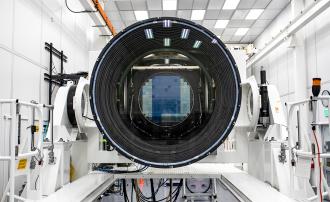Astronomers unveil world’s largest digital camera
In 2024, a new telescope will begin capturing the widest, deepest views of the universe using the biggest digital camera in the world — but its ability to revolutionize astronomy is in jeopardy.
The challenge: Despite sending more than a dozen telescopes into space and erecting even more here on Earth, we’ve still imaged only a small fraction of the universe, which is limiting our understanding of its composition, formation, and more.
We’re not just missing objects that are really far away, either. Astronomers estimate that 60% of the near-Earth objects (NEOs) large enough to flatten a city upon impact have yet to be discovered. We can’t protect Earth from killer asteroids that we don’t know exist.
“The goal is to record the greatest timelapse of the universe ever made.”
The Rubin Observatory
LSST Camera: Astronomers at the Department of Energy’s SLAC National Accelerator Laboratory in California are building the Legacy Survey of Space and Time (LSST) Camera to fill in some of these knowledge gaps.
The 3-ton, 3,200-megapixel device is the largest digital camera in the world. Starting in 2024, it’ll be used to take an unprecedented 10-year-long survey of the night sky from the Vera C. Rubin Observatory, which is currently under construction in Chile.
“Rubin Observatory will image the entire visible sky every few nights, thus capturing changes and opening up the time-domain window to the observable universe,” according to the observatory’s website. “Ultimately, in 10 years of observing, the goal is to record the greatest timelapse of the universe ever made.”
Why it matters: Over the course of the survey, astronomers expect to discover 20 billion galaxies, 17 billion stars, and up to 90% of the NEOs big enough to destroy cities. They also expect images from the LSST camera to improve our understanding of dark matter, dark energy, the formation of the Milky Way, and more.
“LSST is giving us a time machine,” SLAC astrophysicist Risa Wechsler told NBC Bay Area. “These images are telling us about the past. When we look farther away, we’re learning about the further away past and keep going.”
Photobombed: SLAC gave the public its first look at the LSST camera in September, but the massive device isn’t quite finished yet — it still needs to have an updated refrigeration system installed and then undergo final testing before it can make the trek to Chile.
That journey is expected to happen in May 2023, with the survey set to begin in 2024. But the coming influx of low-Earth orbit satellites (LEOsats) might prevent the project from being as productive as scientists hope.
SpaceX has requested authorization to deploy 42,000 Starlink satellites into low-Earth orbit. If it does, up to 30% of the images captured by the LSST Camera could include bright satellite streaks, warn Rubin Observatory scientists.
“Operators of satellites in LEO will present a significant threat to the main mission of LSST: discovery of the unexpected.”
Rubin Observatory Scientists
SpaceX isn’t the only company planning to deploy huge swathes of satellites, either. The number of LEOsats in space could exceed 400,000 before the end of the decade, according to the Rubin team, and if that happens, all of its LSST images are likely to be marred.
The scientists are now working with SpaceX to find solutions to the problem — if the brightness of the Starlink satellites can be sufficiently reduced, for example, they might be able to use algorithms to remove residual signs of the sats from their LSST Camera images.
“It is already known, however,” they write, “that other operators of satellites in LEO will present a significant threat to the main mission of LSST: discovery of the unexpected.”
We’d love to hear from you! If you have a comment about this article or if you have a tip for a future Freethink story, please email us at tips@freethink.com.
